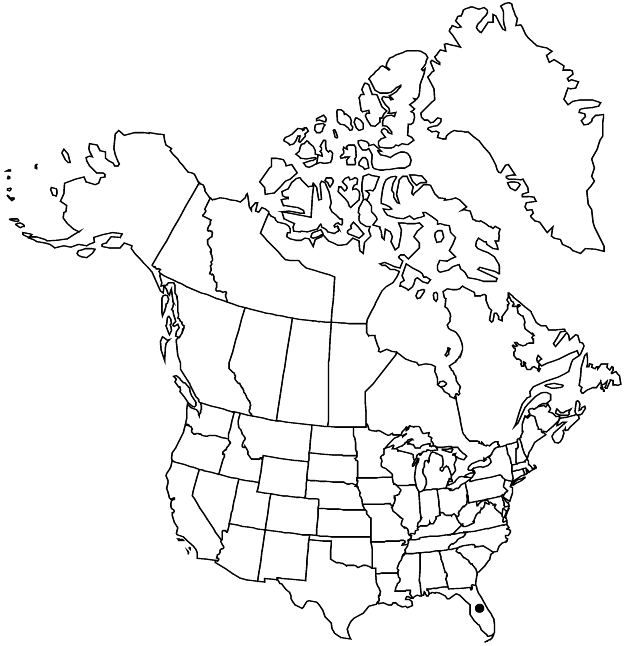Difference between revisions of "Sideroxylon salicifolium"
in J. Lamarck and J. Poiret, Tabl. Encycl. 2: 42. 1794 ,.
FNA>Volume Importer |
FNA>Volume Importer |
||
| Line 14: | Line 14: | ||
|name=Bumelia salicifolia | |name=Bumelia salicifolia | ||
|authority=(Linnaeus) Swartz | |authority=(Linnaeus) Swartz | ||
| − | }}{{Treatment/ID/Synonym | + | }} {{Treatment/ID/Synonym |
|name=Dipholis salicifolia | |name=Dipholis salicifolia | ||
|authority=(Linnaeus) A. de Candolle | |authority=(Linnaeus) A. de Candolle | ||
| − | }}{{Treatment/ID/Synonym | + | }} {{Treatment/ID/Synonym |
|name=Dipholis salicifolia var. jamaicensis | |name=Dipholis salicifolia var. jamaicensis | ||
|authority=Pierre ex Pierre & Urban | |authority=Pierre ex Pierre & Urban | ||
| Line 35: | Line 35: | ||
|elevation=0-100[-1500] m | |elevation=0-100[-1500] m | ||
|distribution=Fla.;Mexico;West Indies;Central America (Belize;Guatemala). | |distribution=Fla.;Mexico;West Indies;Central America (Belize;Guatemala). | ||
| − | |discussion=<p>Sideroxylon salicifolium is recognizable readily by twigs lacking short shoots and thorns, glabrous or glabrate abaxial leaf surfaces, glabrous ovaries, and the presence of endosperm. Prior to T. D. Pennington’s (1990) treatment, most authors (e.g., A. Cronquist 1945c) placed S. salicifolium in Dipholis, based on the aforementioned characteristics. Molecular phylogenetic analyses by U. Swenson and A. A. Anderberg (2005) provided robust support for the nesting of S. salicifolium + S. foetidissimum among other sampled species of Sideroxylon. Cronquist noted its similarities in vegetative characters to the neotropical S. persimile (Hemsley) Pennington; the two are differentiated using flower and fruit characters (Pennington).</p> | + | |discussion=<p><i>Sideroxylon salicifolium</i> is recognizable readily by twigs lacking short shoots and thorns, glabrous or glabrate abaxial leaf surfaces, glabrous ovaries, and the presence of endosperm. Prior to T. D. Pennington’s (1990) treatment, most authors (e.g., A. Cronquist 1945c) placed <i>S. salicifolium</i> in Dipholis, based on the aforementioned characteristics. Molecular phylogenetic analyses by U. Swenson and A. A. Anderberg (2005) provided robust support for the nesting of <i>S. salicifolium</i> + <i>S. foetidissimum</i> among other sampled species of <i>Sideroxylon</i>. Cronquist noted its similarities in vegetative characters to the neotropical S. persimile (Hemsley) Pennington; the two are differentiated using flower and fruit characters (Pennington).</p> |
|tables= | |tables= | ||
|references= | |references= | ||
| Line 59: | Line 59: | ||
|publication year= | |publication year= | ||
|special status= | |special status= | ||
| − | |source xml=https://jpend@bitbucket.org/aafc-mbb/fna-data-curation.git/src/ | + | |source xml=https://jpend@bitbucket.org/aafc-mbb/fna-data-curation.git/src/8f726806613d60c220dc4493de13607dd3150896/coarse_grained_fna_xml/V8/V8_502.xml |
|genus=Sideroxylon | |genus=Sideroxylon | ||
|species=Sideroxylon salicifolium | |species=Sideroxylon salicifolium | ||
Revision as of 18:07, 18 September 2019
Shrubs or trees, to 25 m. Stems not armed, glabrate. Leaves deciduous; petiole 6–14 mm, glabrous or glabrate; blade (lustrous dark green adaxially), elliptic, 24–111 × 12–40 mm, base attenuate, margins plane, apex acute to acuminate, abaxial surface glabrous or glabrate with hairs scattered along midrib (hairs reddish brown), venation visible, adaxial surface glabrous, midrib slightly raised, marginal vein present. Inflorescences 5–14-flowered. Pedicels 1–5 mm, sericeous (hairs reddish brown). Flowers: calyx 1.5–2.5 mm diam.; sepals 5, 1.5–1.6 × 1.3–1.8 mm, sericeous (hairs white to tawny); petals 5, white to cream, median segment ovate to suborbiculate, 1.6–1.8 mm, lateral segments lanceolate, 1.3–1.6 mm; stamens 5, 2.8–3.5 mm; staminodes lanceolate, 1.8–2.2 mm, erose; anthers lanceolate-sagittate, 0.8–1.3 mm; pistil 5-carpellate; ovary 5-locular, 1–1.2 mm, glabrous; style 0.9–1.5 mm. Berries purplish black, broadly ellipsoid to subglobose, 6–10 mm, glabrous. Seeds 4–6 mm.
Phenology: Flowering Feb–May.
Habitat: Pine woodlands and savannas, hammocks
Elevation: 0-100[-1500] m
Distribution

Fla., Mexico, West Indies, Central America (Belize, Guatemala).
Discussion
Sideroxylon salicifolium is recognizable readily by twigs lacking short shoots and thorns, glabrous or glabrate abaxial leaf surfaces, glabrous ovaries, and the presence of endosperm. Prior to T. D. Pennington’s (1990) treatment, most authors (e.g., A. Cronquist 1945c) placed S. salicifolium in Dipholis, based on the aforementioned characteristics. Molecular phylogenetic analyses by U. Swenson and A. A. Anderberg (2005) provided robust support for the nesting of S. salicifolium + S. foetidissimum among other sampled species of Sideroxylon. Cronquist noted its similarities in vegetative characters to the neotropical S. persimile (Hemsley) Pennington; the two are differentiated using flower and fruit characters (Pennington).
Selected References
None.